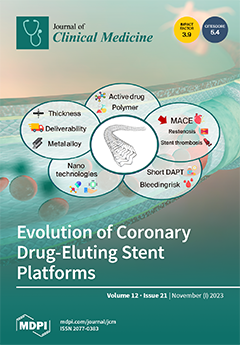Background: The integration of continuous glucose monitoring systems with insulin infusion pumps has shown improved glycemic control, with improvements in hyperglycemia, hypoglycemia, Hb1Ac, and greater autonomy in daily life. These have been most studied in adults and there are currently not many articles
[...] Read more.
Background: The integration of continuous glucose monitoring systems with insulin infusion pumps has shown improved glycemic control, with improvements in hyperglycemia, hypoglycemia, Hb1Ac, and greater autonomy in daily life. These have been most studied in adults and there are currently not many articles published in the pediatric population that establish their correlation with age of debut. Methods: Prospective, single-study. A total of 28 patients (mean age 12 ± 2.43 years, 57% male, duration of diabetes 7.84 ± 2.46 years) were included and divided into two groups according to age at T1D onset (≤4 years and >4 years). Follow-up for 3 months, with glucometric variables extracted at different cut-off points after the start of the closed-loop (baseline, 1 month, 3 months). Results: Significant improvement was evidenced at 1 month and 3 months after closed-loop system implantation, with better glycemic control in the older age group at baseline at TIR (74.06% ± 6.37% vs. 80.33% ± 7.49% at 1 month,
p < 0.003; 71.87% ± 6.58% vs. 78.75% ± 5.94% at 3 months,
p < 0.009), TAR1 (18.25% ± 4.54% vs. 14.33% ± 5.74% at 1 month,
p < 0.006; 19.87% ± 5.15% vs. 14.67% ± 4. 36% at 3 months,
p < 0.009) and TAR2 (4.75% ± 2.67% vs. 2.75% ± 1.96% at 1 month,
p = 0.0307; 5.40% ± 2.85% vs. 3% ± 2.45% at 3 months,
p < 0.027). Conclusions: the use of automated systems such as the MiniMed
TM780G system brings glucometric results closer to those recommended by consensus, especially in age at T1D onset >4 years. However, the management in pediatrics continues to be a challenge even after the implementation of these systems, especially in terms of hyperglycemia and glycemic variability.
Full article






